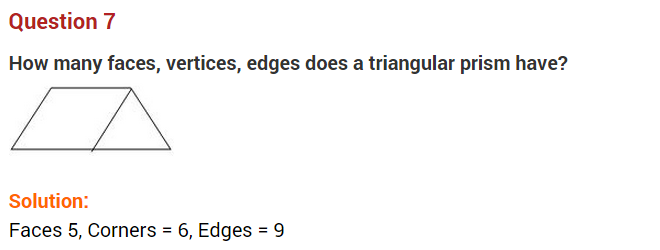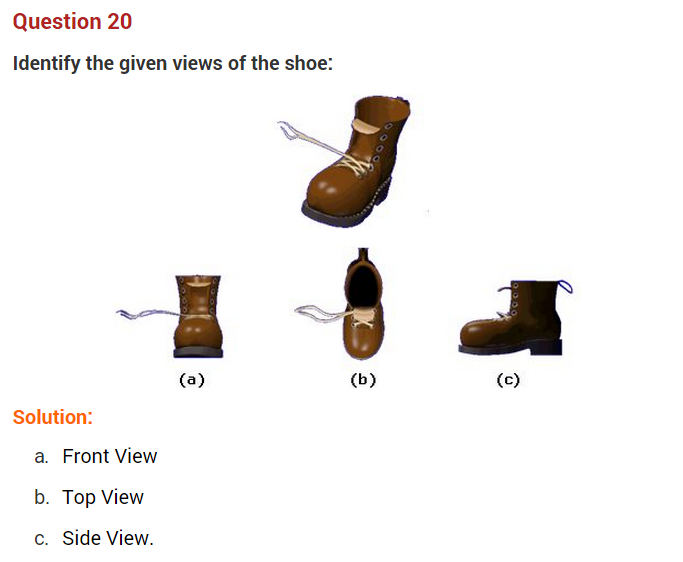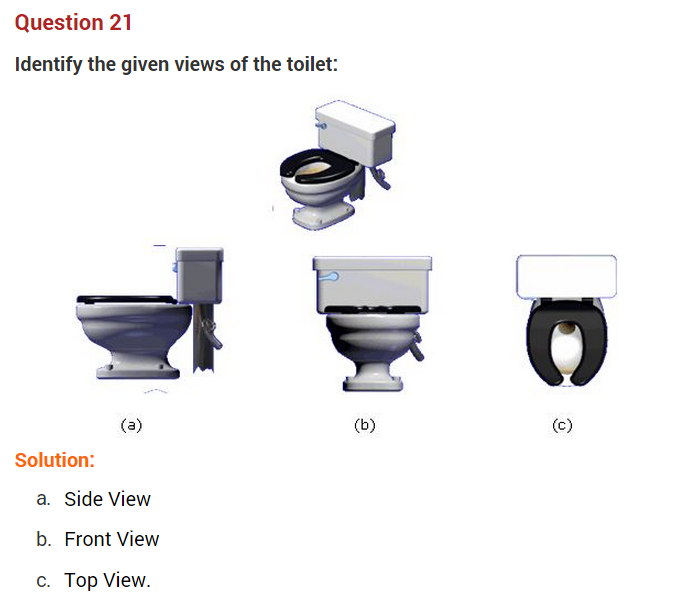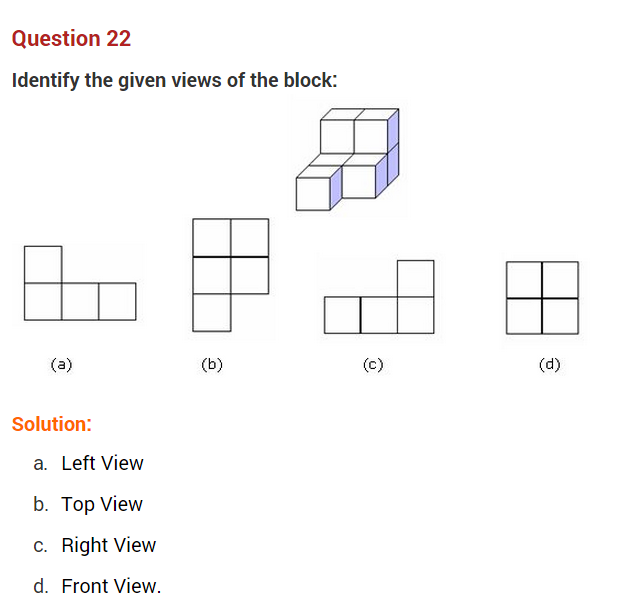NCERT Solutions for Class 8 Maths Chapter 10 Visualising Solid Shapes
NCERT Solutions for Class 8 Maths Chapter 10 Visualising Solid Shapes Exercise 10.1
Ex 10.1 Class 8 Maths Question 1.
For each of the given solid, the two views are given. Match for each solid the corresponding top and front views. The first one is done for you.
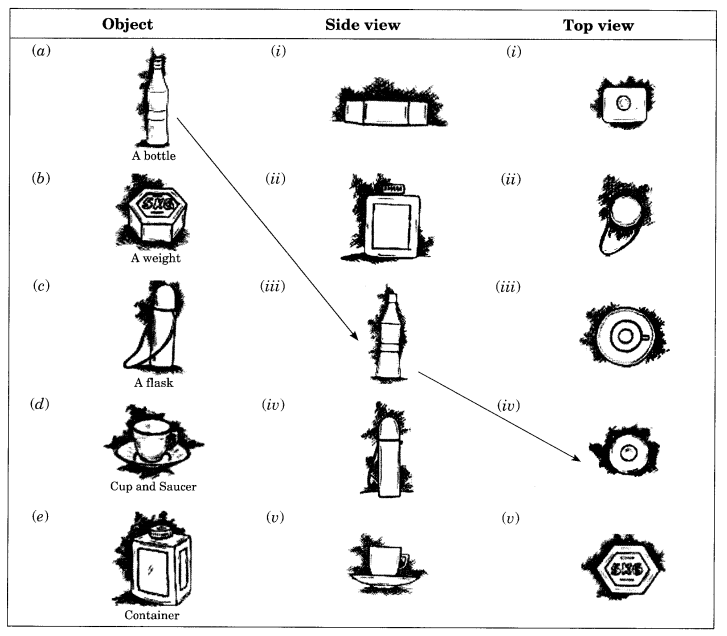
Solution:
(a) A bottle → (iii) → (iv)
(b) A weight → (i) → (v)
(c) A flask → (iv) → (ii)
(d) Cup and saucer → (v) → (iii)
(e) Container → (ii) → (i)
Ex 10.1 Class 8 Maths Question 2.
For each of the given solid, the three views are given. Identify for each solid the corresponding top, front and side views.

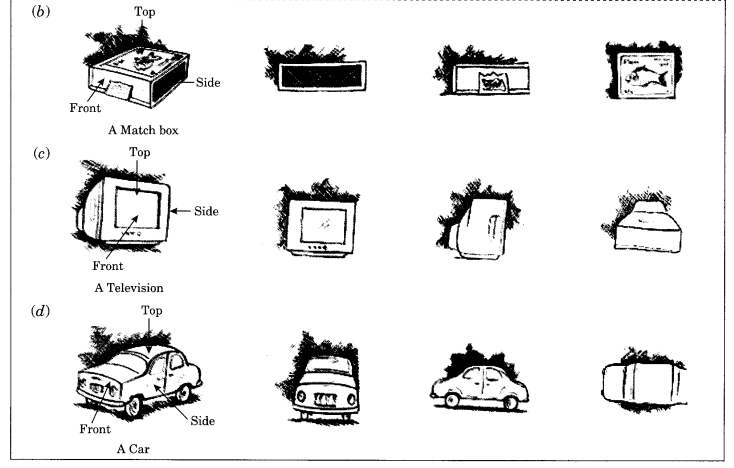
Solution:
(a) An Almirah → (i) Front → (ii) Side → (iii) Top
(b) A Match box → (i) Side → (it) Front → (iii) Top
(c) A Television → (i) Front → (ii) Side → (iii) Top
(d) A Car → (i) Front → (ii) Side → (iii) Top
Ex 10.1 Class 8 Maths Question 3.
For each given solid, identify the top view, front view and side view.
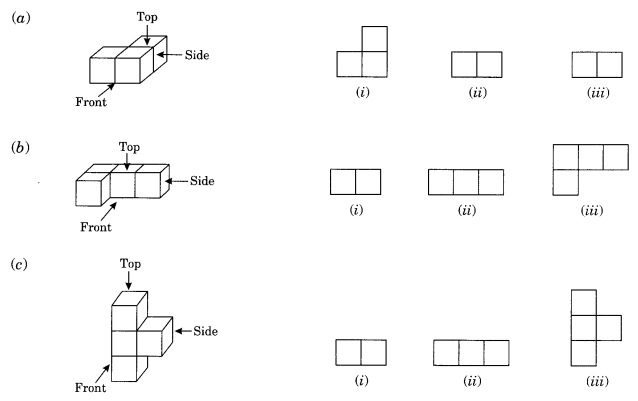
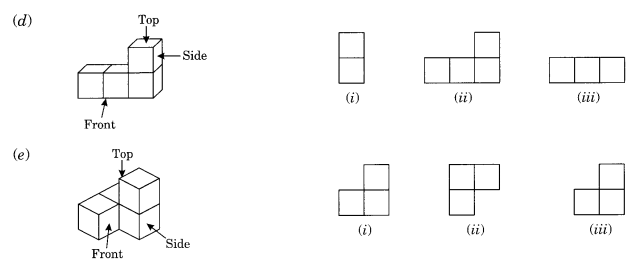
Solution:
(a) (i) Top → (ii) Front → (iii) Side
(b) (i) Side → (ii) Front → (iii) Top
(c) (i) Top → (ii) Side → (iii) Front
(d) (i) Side → (ii) Front → (iii) Top
(e) (i) Front → (ii) Top → (iii) Side
Ex 10.1 Class 8 Maths Question 4.
Draw the front view, side view and top view of the given objects.
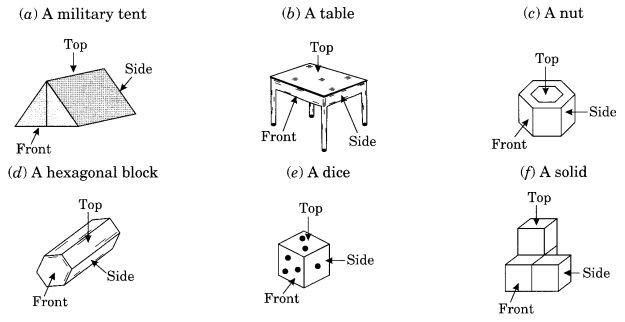
Solution:
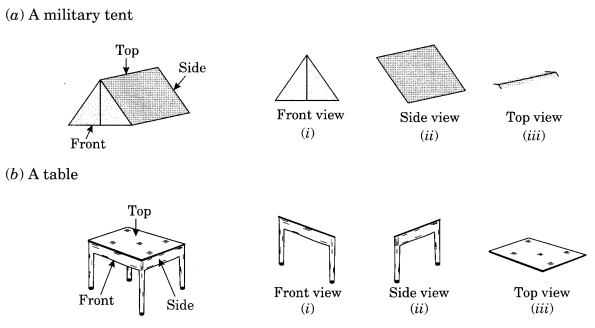
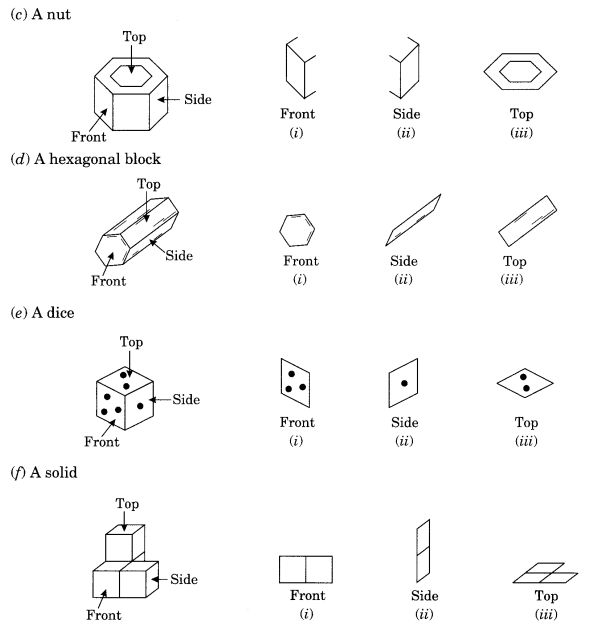



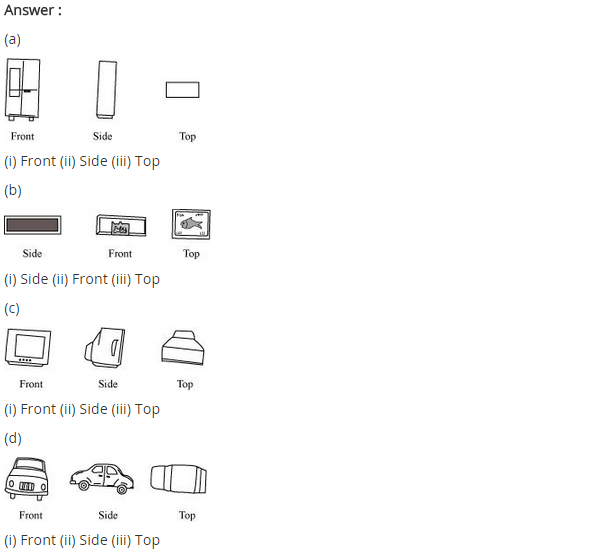
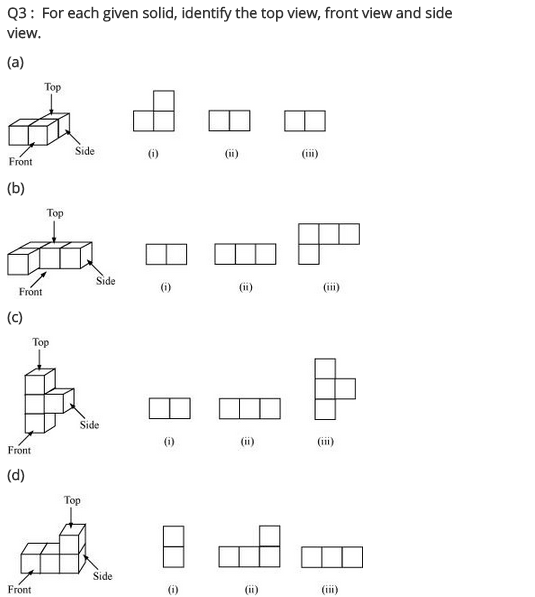
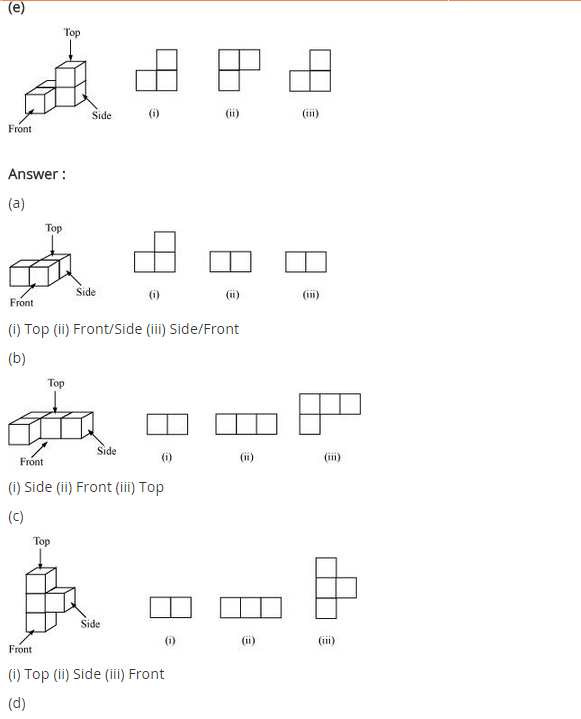
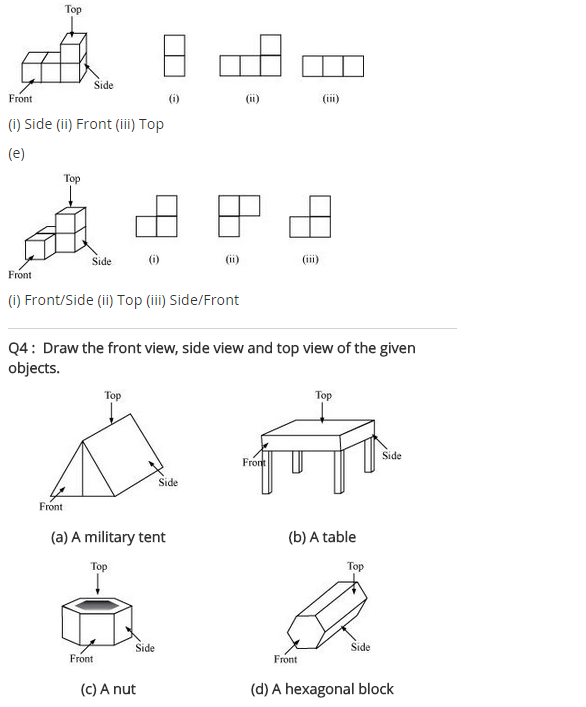
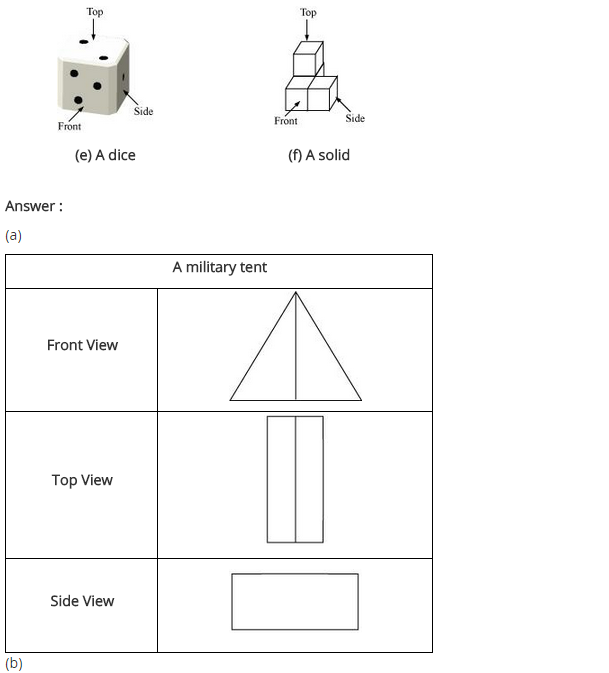
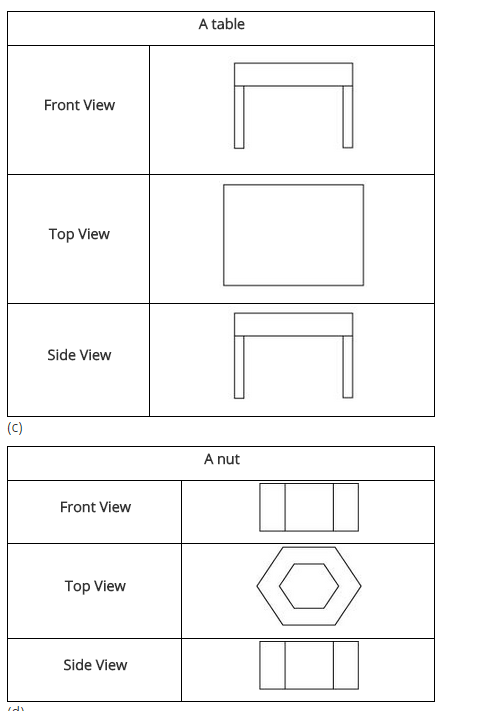
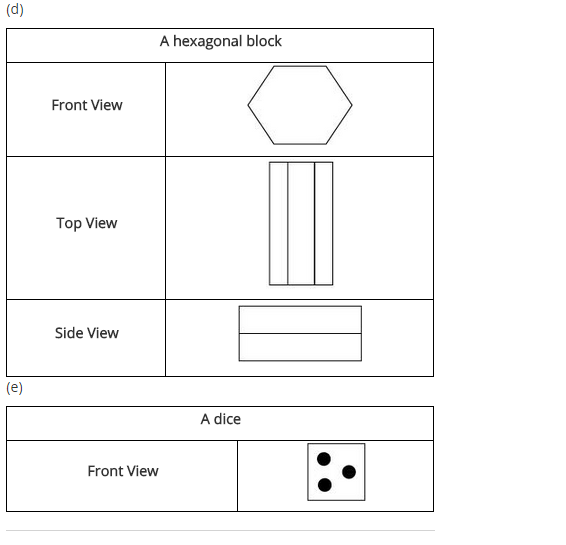
NCERT Solutions for Class 8 Maths Chapter 10 Visualising Solid Shapes Exercise 10.2
Ex 10.2 Class 8 Maths Question 1.
Look at the given map of a city.
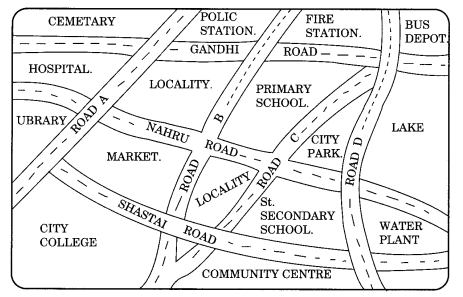
Answer the following.
(a) Colour the map as follows: Blue-water, red- fire station, orange-library, yellow-schools, Green-park, Pink-College, Purple-Hospital, Brown-Cemetery.
(b) Mark a green ‘X’ at the intersection of Road ‘C’ and Nehru Road, Green ‘Y’ at the intersection of Gandhi Road and Road A.
(c) In red, draw a short street route from Library to the bus depot.
(d) Which is further east, the city park or the market?
(e) Which is further south, the primary school or the Sr. Secondary School?
Ex 10.2 Class 8 Maths Question 2.
Draw a map of your classroom using proper scale and symbols for different objects.
Ex 10.2 Class 8 Maths Question 3.
Draw a map of your school compound using proper scale and symbols for various features like a playground, main building, garden etc.
Ex 10.2 Class 8 Maths Question 4.
Draw a map giving instructions to your friend so that she reaches your house without any difficulty.
Solution:
Question 1 to Question 4 each all activities. You can try yourself.
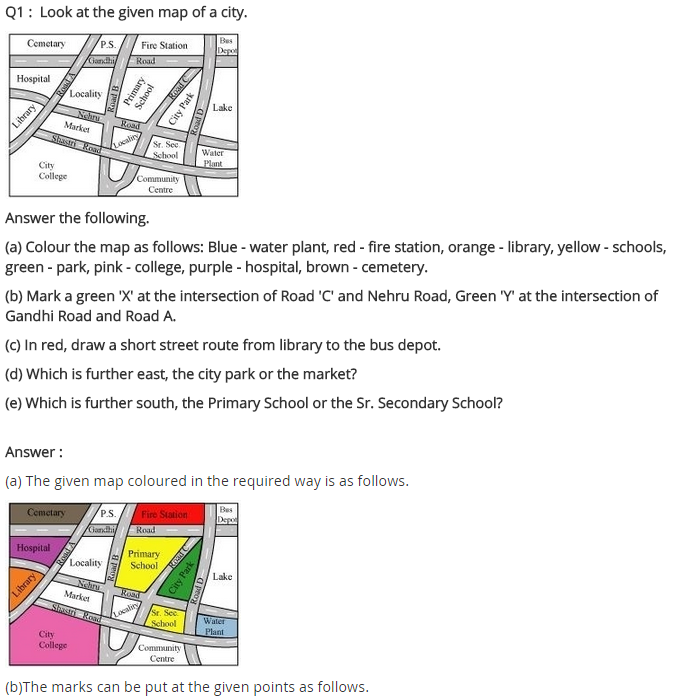
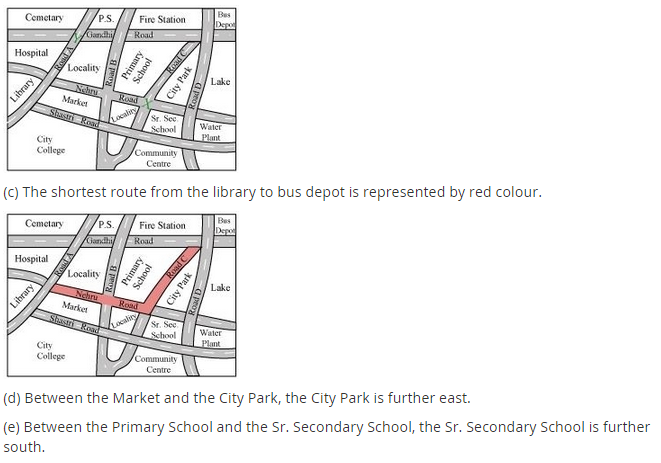
NCERT Solutions for Class 8 Maths Chapter 10 Visualising Solid Shapes Exercise 10.3
Ex 10.3 Class 8 Maths Question 1.
Can a polyhedron have for its faces
(i) 3 triangles?
(ii) 4 triangles?
(iii) a square and four triangles?
Solution:
(i) No, because polyhedron must have edges meeting at vertices which are points.
(ii) Yes, because all the edges are meeting at the vertices.
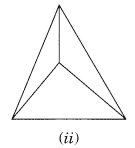
(iii) Yes, because all the eight edges meet at the vertices.
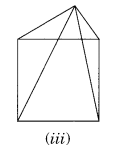
Ex 10.3 Class 8 Maths Question 2.
Is it possible to have a polyhedron with any given number of faces?
(Hint: Think of a pyramid)
Solution:
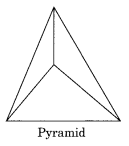
Yes, it is possible if the number of faces is greater than or equal to 4.
Example: Pyramid which has 4 faces.
Ex 10.3 Class 8 Maths Question 3.
Which are prisms among the following?
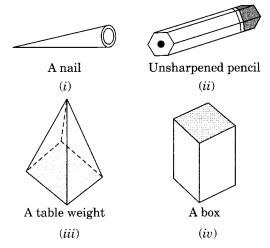
Solution:
Only (ii) unsharpened pencil and (iv) a box are the prism.
Ex 10.3 Class 8 Maths Question 4.
(i) How are prisms and cylinders alike?
(ii) How are pyramids and cones alike?
Solution:
(i) If the number of sides in a prism is increased to certain extent, then the prism will take the shape of cylinder.
(ii) If the number of sides of the pyramid is increased to same extent, then the pyramid becomes a cone.
Ex 10.3 Class 8 Maths Question 5.
Is a square prism same as a cube? Explain.
Solution:
Every square prism cannot be cube. It may be cuboid also.
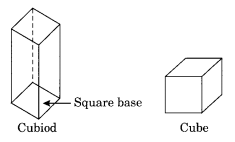
Ex 10.3 Class 8 Maths Question 6.
Verify Euler’s formula for these solids.
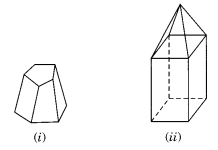
Solution:
(i) Faces = 7
Sides = 15
Vertices = 10
Euler’s formula: F + V – E = 2
⇒ 7 + 10 – 15 = 2
⇒ 2 = 2
Hence, Euler’s formula is verified.
(ii) Faces = 9
Sides = 16
Vertices = 9
Euler’s Formula: F + V – E = 2
⇒ 9 + 9 – 16 = 2
⇒ 2 = 2
Hence, Euler’s formula is verified.
Ex 10.3 Class 8 Maths Question 7.
Using Euler’s formula find the unknown.
| Faces | ? | 5 | 20 |
| Vertices | 6 | ? | 12 |
| Edges | 12 | 9 | ? |
Solution:
| Faces | 8 | 5 | 20 |
| Vertices | 6 | 6 | 12 |
| Edges | 12 | 9 | 30 |
Using Eulers Formula: F + V – E = 2
Ex 10.3 Class 8 Maths Question 8.
Can a polyhedron have 10 faces, 20 edges and 15 vertices?
Solution:
Here faces = 10, Edges = 20, Vertices = 15
According to Euler’s Formula:
F + V – E = 2
⇒ 10 + 15 – 20 = 25 – 20
⇒ 5 ≠ 2
A polyhedron do not have 10 Faces, 20 Edges and 15 Vertices.
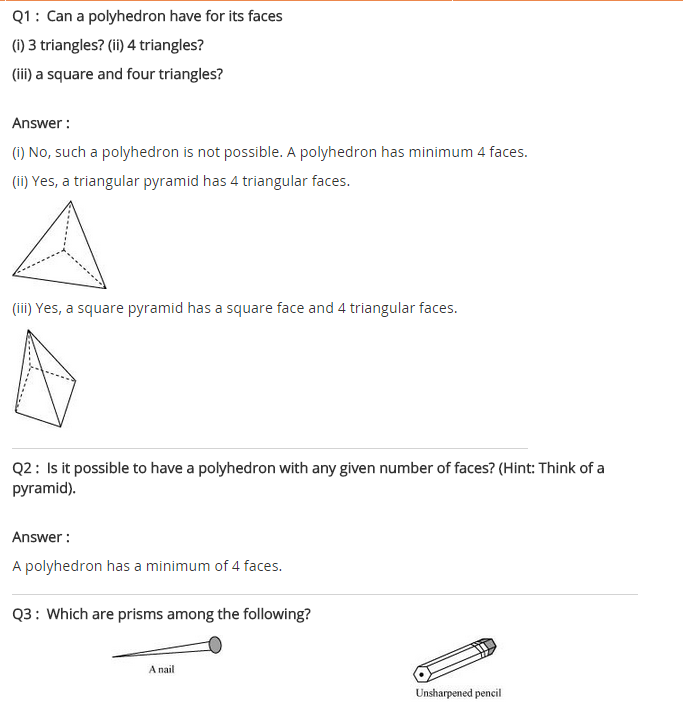
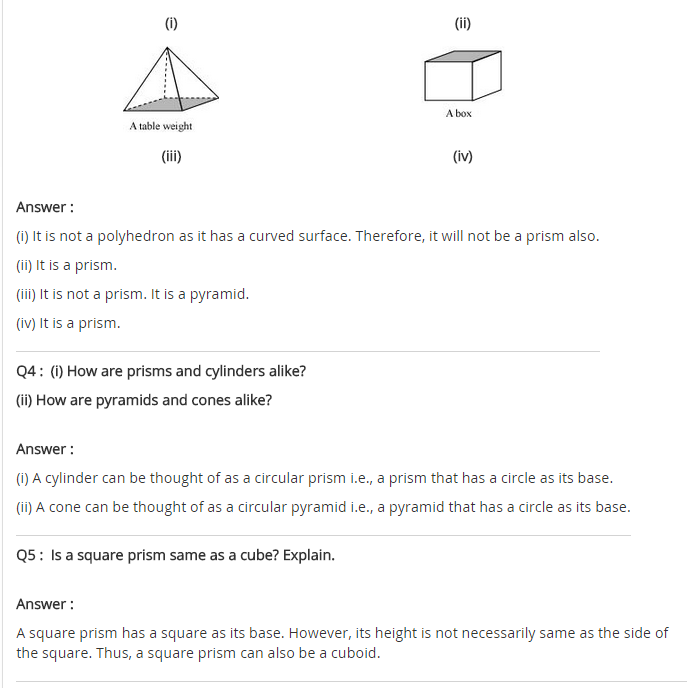
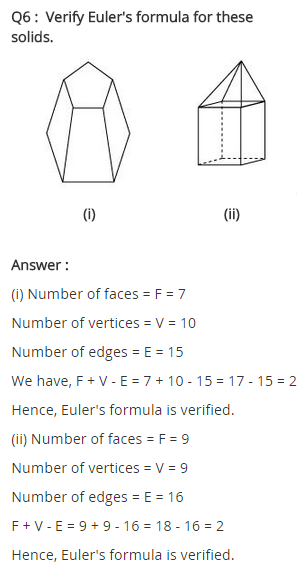
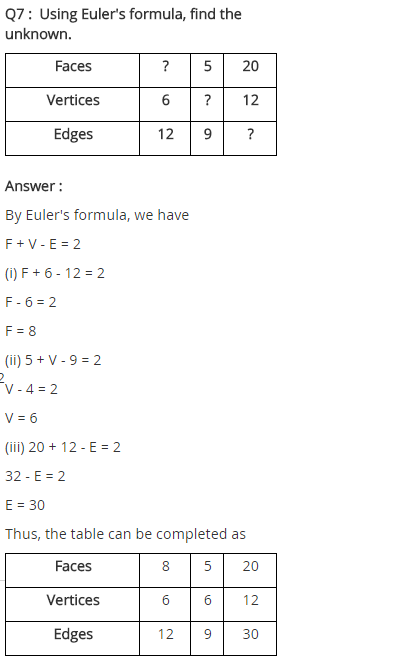
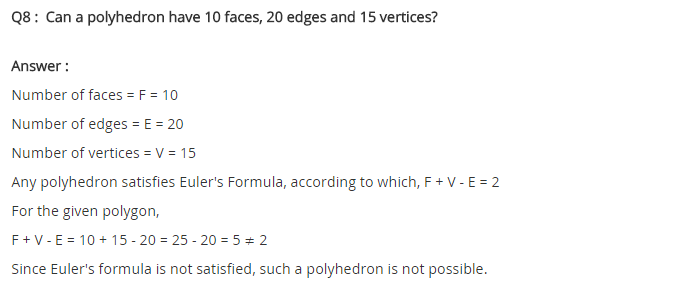
Visualising Solid Shapes Class 8 Extra Questions Maths Chapter 10
Extra Questions for Class 8 Maths Chapter 10 Visualising Solid Shapes
Visualising Solid Shapes Class 8 Extra Questions Very Short Answer Type
Question 1.
Draw any four 3-dimensional figures.
Solution:

Question 2.
Verify Euler’s formula for a right triangular prism.

Solution:
Number of vertices (V) = 6
Number of faces (F) = 5
and number of edges (E) = 9
Euler’s formula:
V + F – E = 2
⇒ 6 + 5 – 9 = 2
⇒ 2 = 2
Hence, the formula is verified.
Question 3.
Find the number of vertices of hexagonal prisms.
Solution:
Number of vertices = 2 × Number of sides = 2 × 6 = 12
Question 4.
Verify whether a polyhedron can have 10 faces, 20 edges and 15 vertices.
Solution:
We have
Number of faces F = 10
Number of edges E = 20
and number of vertices V = 15
Euler’s formula:
V + F – E = 2
⇒ 15 + 10 – 20 = 2
⇒ 5 ≠ 2
Hence, it is not possible to have a polyhedron satisfying the above data.
Question 5.
If F = 18 and V = 10, then find the value of E in Euler’s formula.
Solution:
We know that
V + F – E = 2
⇒ 10 + 18 – E = 2
⇒ 28 – E = 2
⇒ E = 28 – 2 = 26
Hence, the required value of E = 26
Question 6.
Draw the front, side and top views of the following 3-D figures.

Solution:

Question 7.
Draw the nets of the following polyhedrons.
(i) Cuboid
(ii) Triangular prism with a base equilateral triangle.
(iii) Square pyramid.
Solution:
(i) The net pattern of cuboid

(ii) The net pattern of a triangular prism

(iii) Net pattern of square pyramid

Question 8.
The given net is made up of two equilateral triangles and three rectangles.

(i) Name the solid it represents.
(ii) Find the number of faces, edges and vertices.
Solution:
(i) The given figure represents the net prims of the triangular prism
(ii) Number of faces = 5
Number of edges = 9
Number of vertices = 6
Visualising Solid Shapes Class 8 Extra Questions Short Answer Type
Question 9.
Match the following:

Solution:
(a) → (vi)
(b) → (v)
(c) → (ii)
(d) → (i)
(e) → (iii)
(f) → (v)
Question 10.
Using Euler’s formula, fill in the blanks:
| Faces | Vertices | Edges | |
| (a) | 6 | 8 | — |
| (b) | — | 10 | 15 |
| (c) | 4 | — | 6 |
| (d) | 5 | 6 | — |
| (e) | 8 | 12 | — |
| (f) | 7 | 7 | — |
Solution:
(a) F + V – E = 2
⇒ 6 + 8 – E = 2
⇒ 14 – E = 2
⇒ E = 14 – 2 = 12
(b) F + V – E = 2
⇒ F + 10 – 15 = 2
⇒ F – 5 = 2
⇒ F = 2 + 5 = 7
(c) F + V – E = 2
⇒ 4 + V – 6 = 2
⇒ V – 2 = 2
⇒ V = 2 + 2 = 4
(d) F +V – E = 2
⇒ 5 + 6 – E = 2
⇒ 11 – E = 2
⇒ E = 11 – 2 = 9
(e) F + V – E = 2
⇒ 8 + 12 – E = 2
⇒ 20 – E = 2
⇒ E = 20 – 2 = 18
(f) F + V – E = 2
⇒ 7 + 7 – E = 2
⇒ 14 – E = 2
⇒ E = 14 – 2 = 12
Hence (a) → 12, (b) → 7, (c) → 4, (d) → 9, (e) → 18, (f) → 12
Question 11.
Name the solids that have:
(i) 4 faces
(ii) 8 triangular faces
(iii) 6 faces
(iv) 1 curved surface
(v) 5 faces and 5 vertices
(vi) 6 rectangular faces and 2 hexagonal faces
Solution:
(i) Tetrahedron
(ii) Regular octahedron
(iii) Cube and cuboid
(iv) Cylinder
(v) Square and a rectangular pyramid
(vi) Hexagonal prism
Question 12.
Complete the table:
| Solid | F | V | E | F + V | E + 2 |
| Cuboid | — | — | — | — | — |
| Triangular pyramid |
— | — | — | — | — |
| Triangular prism | — | — | — | — | — |
| Pyramid with square base | — | — | — | — | — |
| Prism with square base | — | — | — | — | — |
Solution:
| Solid | F | V | E | F + V | E + 2 |
| Cuboid | 6 | 8 | 12 | 14 | 14 |
| Triangular pyramid |
4 | 4 | 6 | 8 | 8 |
| Triangular prism |
5 | 6 | 9 | 11 | 11 |
| Pyramid with square base | 5 | 5 | 8 | 10 | 10 |
| Prism with square base | 6 | 8 | 12 | 14 | 14 |
Question 13.
Use isometric dot paper to sketch a rectangular prism with length 4 units, height 2 units and width 3 units. (NCERT Exemplar)
Solution:
Steps:
1. Draw a parallelogram with sides 4 units and 3 units. This is the top of the prism (Fig. 1).

2. Start at one vertex. Draw a line passing through two dots. Repeat for the other three vertices. Draw the hidden edges as a dashed line (Fig. 2).

3. Connect the ends of the lines to complete the prism (Fig. 3).







